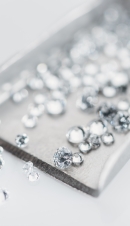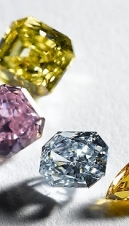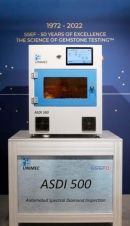Archive
- 27/09/2024 10:04
Despite the fact that De Beers announced in June that it would stop the production of lab-grown diamonds for jewelry, the company today is launching a new fall campaign, titled "Modern Family", for its lab-grown brand Lightbox. These developments clearly affirm the brand’s commitment to the lab-grown diamond market. De Beers is to stop producing diamonds for jewelry when it comes to Oregon, but the company will continue to focus on innovating and growing the brand.
- 21/08/2024 07:10
According to news reports, Israeli lab-grown producer Lusix is seeking a protection from creditors through a debt settlement, with debts to three Israeli banks amounting to US$15m, following unsuccesful attempts to raise additional funding from existing investors. Led by entrepreneur Benny Landa, Lusix is said to initially have raised US$150m, including US$60m from the Landa Group and US$90m from other investors, led by luxury giant LVMH, but the company got in trouble as LGD prices collapsed by more than 90% in recent months.
Photo Credit: Lusix
- 02/08/2024 07:03
The price of lab-grown diamonds has fallen significantly in recent years. In July 2022, the price was $300 per carat, but by mid-2024 it had dropped to just $78 per carat. This significant decline is primarily due to an oversupply of the product and the rapid advancement in production technologies, which has made these diamonds more accessible to the consumer but also less valuable in terms of resale. Initially welcomed for their affordability and ethical credentials, lab-grown diamonds are now flooding the market.
- 26/07/2024 16:18
Diam Concept, a French company celebrated for its innovative approach to lab-grown diamonds and partly financed by Chanel, has recently faced a significant financial setback and went into receivership in May. Founded in 2016, Diam Concept gained attention for its cutting-edge use of chemical vapor deposition (CVD) technology to produce high-quality diamonds.
- 13/06/2024 07:29
According to the New York Post, jewellery retail giant Signet, started printing a buyer's warning on all of its Labgrown Diamond sales. The statement reads "Lab-created diamonds have the same optical, chemical and physical properties as natural diamonds. However, because lab-created diamonds can be produced in abundance, they are less expensive and make larger diamonds more affordable.
- 31/05/2024 22:16
In a bold move to revive its heritage, De Beers announced it will cease producing lab-grown diamonds for jewelry, focusing instead on natural stones. This decision follows a tough year of declining sales and strategic uncertainties, as parent company Anglo American considers divestiture options.
A Strategic Shift
- 31/05/2024 09:54
In a surprising move, Botswana President Masisi yesterday left the country to join industry stakeholders at the 2024 JCK Las Vegas show. Botswana finds itself in the middle of a perfect storm of challenges: De Beers' parent company Anglo American recently became the target of potential take-over bids, which led to Anglo announcing plans to spin off its diamond business.
- 17/05/2024 09:50
Are lab-grown diamonds, to the naked eye identical to and sharing identical chemical and physical properties with natural diamonds, but 40-50% less expensive, that sustainable as often claimed by its producers?
- 11/05/2024 08:40
De Beers has announced its LGD line Lightbox is lowering prices of its offering from the initial US$800/ct and US$1500/ct for high colors, and adds "batch grading" reports from GIA based on sample grading. New Lightbox pricing (up to -40% from previous pricing) is lower than most lab-grown retail prices, JCK reports.
• I-J color, VS, very good cut: US$500/ct
• G-H color, VS, very good cut: US$600/ct
• D-E-F color, VS, excellent cut: US$900/ctPhoto credit: Lightbox
- 07/05/2024 06:58
About 100 units in India's LGD growing and manufacturing industry have voted to observe a 15-day summer holiday starting May 15, hoping to control the rough and polished LGD supply and stopping the massive price drops seen in the LGD market. Traditionally, the (natural) diamond industry closes shop for a holiday period during Diwali.
- 26/04/2024 06:59
The words of Botswana's President Masisi during his opening address of AWDC's Facets conference in Gaborone last year, when he described Lab-Grown Diamonds (LGD) as "microwave diamonds" come to mind as news came that South Korean scientist claim to have produced a synthetic diamond in little over two hours, using a new method that omits the need to mimic the immense pressure needed to form a diamond artificially. LGD production processes to date still require a significant amount of time to produce a diamond.
- 20/04/2023 11:09
Natural Diamond Council, the authoritative resource on natural diamonds, has released its 2023 analytical report entitled, Diamond Facts: Addressing myths and misconceptions about the diamond industry. Through this report, the Natural Diamond Council (NDC) set out to address misinformation about both natural diamonds and laboratory-grown diamonds for industry players, retailers, and consumers alike.
- 03/02/2023 17:21
The Indian Minister of Commerce and Industry in her Unioin Budget speech this week proposed certain budget allotments and new policies for the 23/24 fiscal year which made several provisions for the diamond sector in India who have recently suffered setbacks due to decreased exports and global market instabilities.
- 15/12/2022 09:30
Jewelry trade publications such as JCK are reporting ever more instances of lab-grown diamonds bearing fraudulent inscriptions linked to grading reports for natural gems. “Given that the resale value of lab-grown diamonds is next to nothing,” said Soraya Cayen, owner of the Carmel, CA. jewelry salon, Cayen Collection, “retailers and consumers alike are understandably seeking confirmation that their diamond is a naturally mined one.”
- 15/06/2022 06:10
Israel-based Lusix, producer of lab-grown diamonds completed an investment round of US$90m, and counts LVMH Luxury Ventures as one of its newly onboarded investors. The company will use the money to expand its production capacity later this year. In a Q&A with JCK News, industry analyst Paul Zimnisky discusses LGD trends, saying LGD prices have been dropping significantly lately as supply is booming. A 1.5ct for example dropped from US$3,500 to US$3,000, Zimnisky noted.
- 14/01/2022 09:02
"And let it be said, the lab-grown companies aren’t exactly charities – they’re like any other technology company out there to make money."














